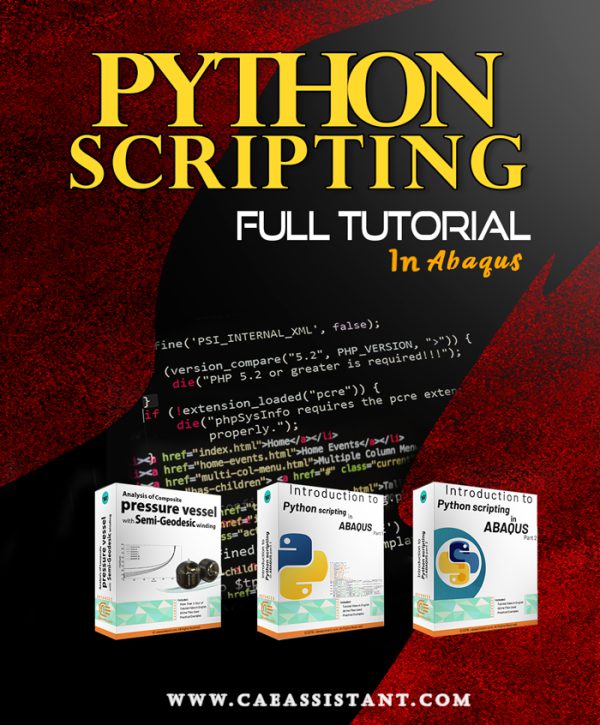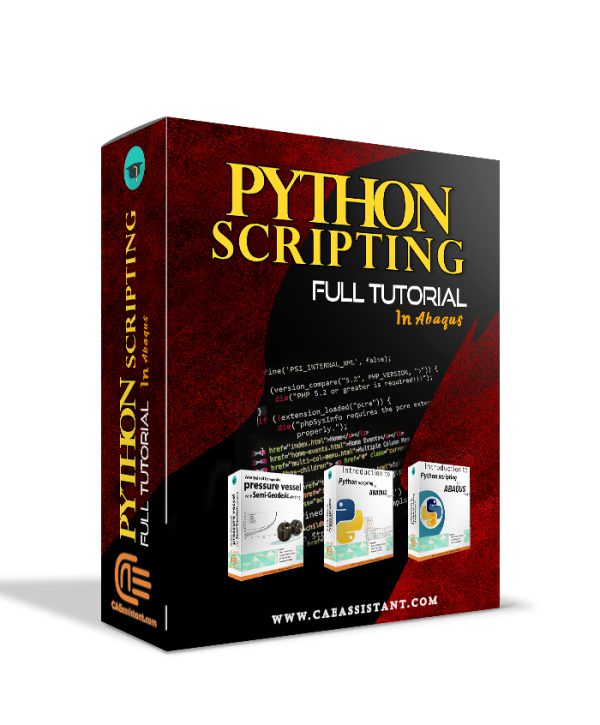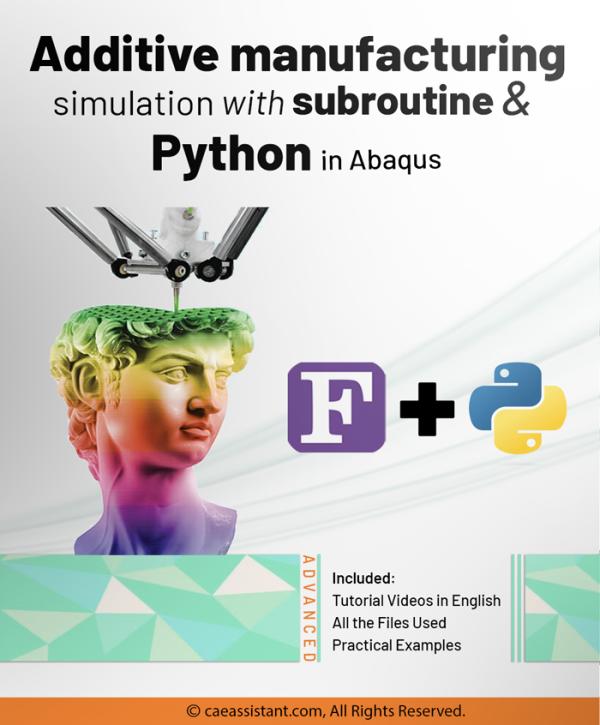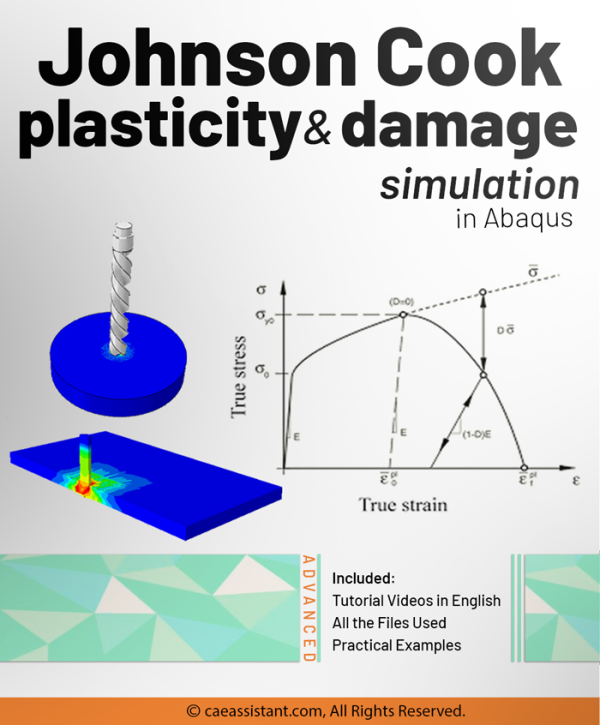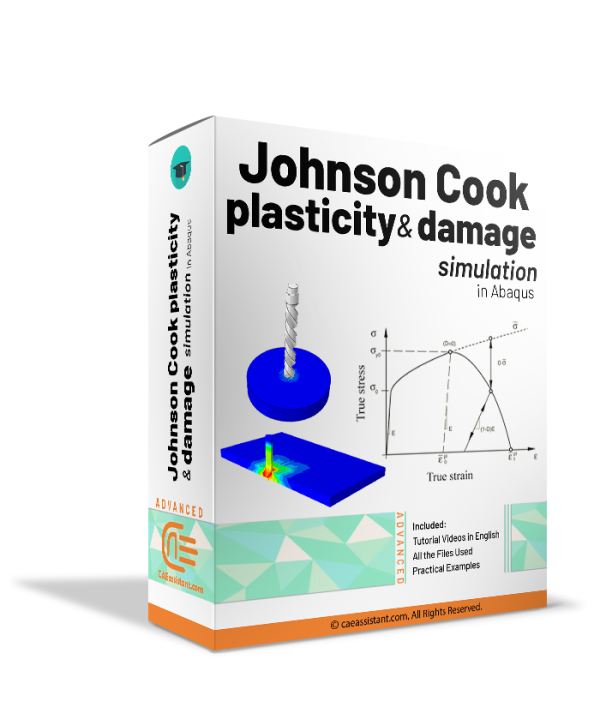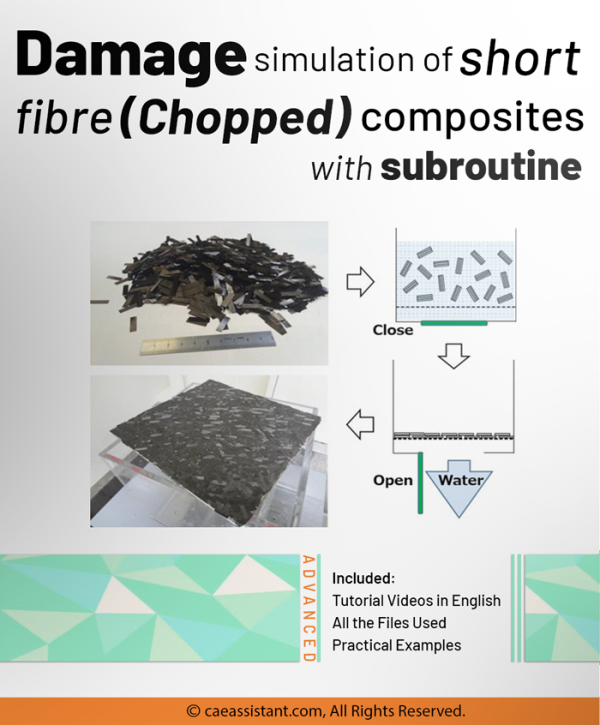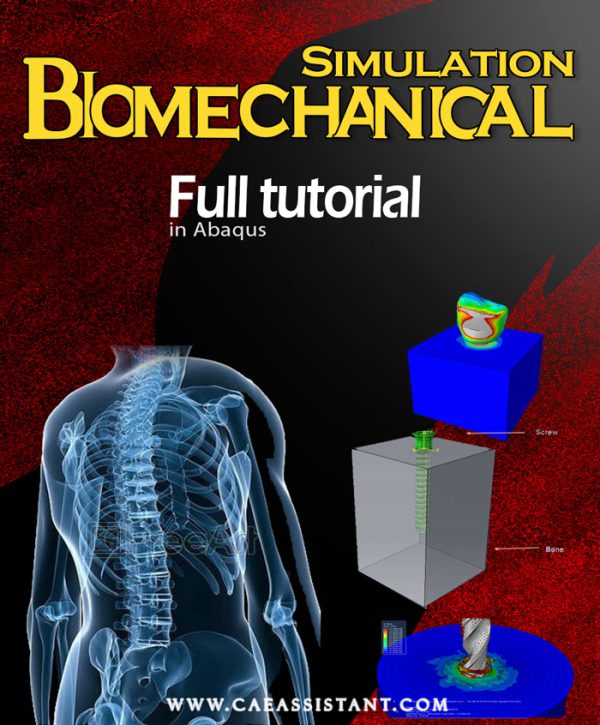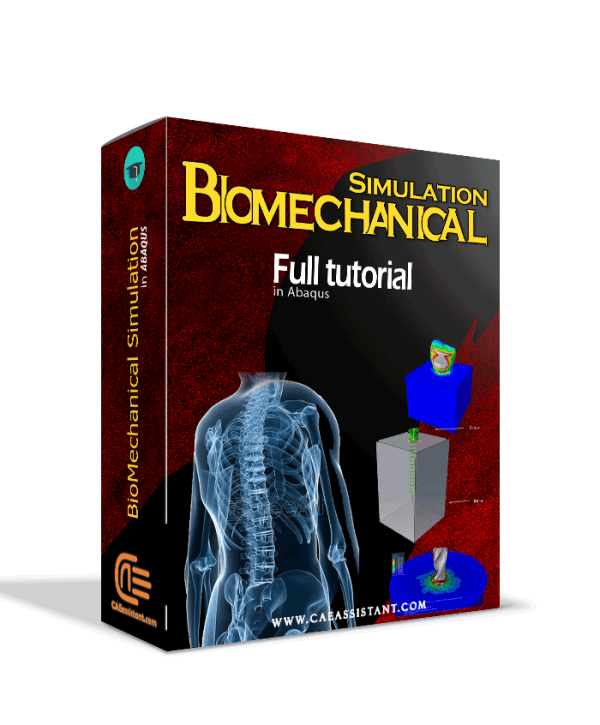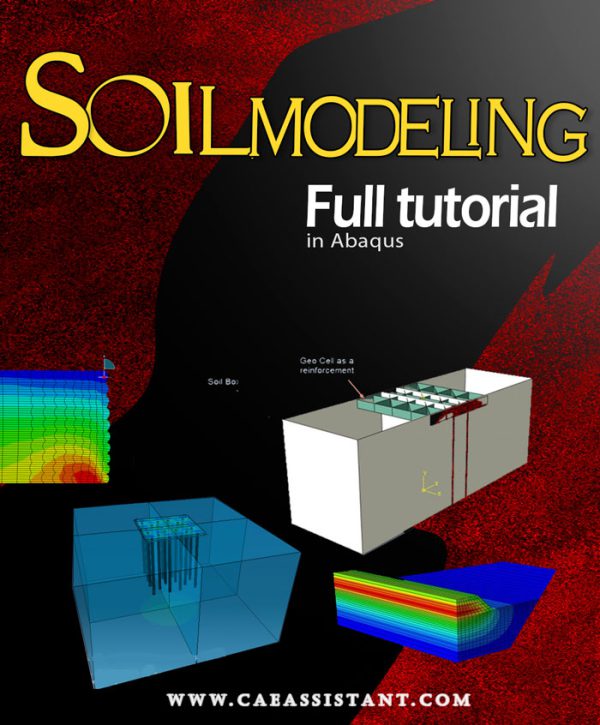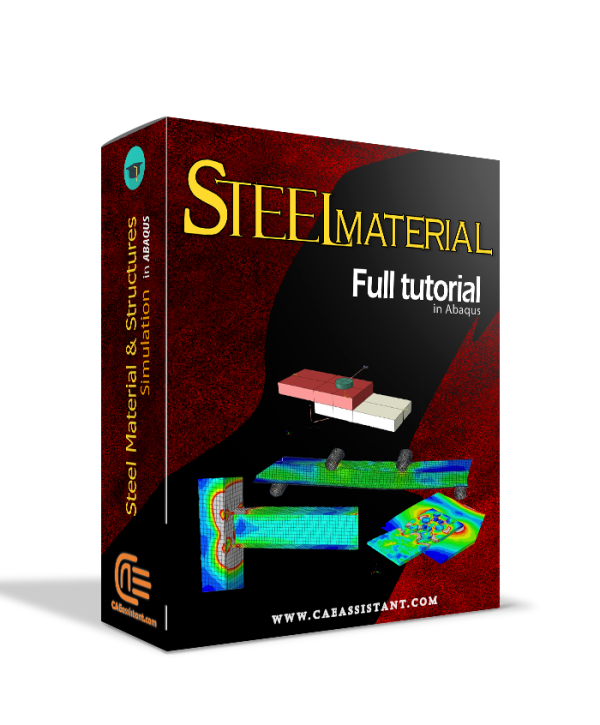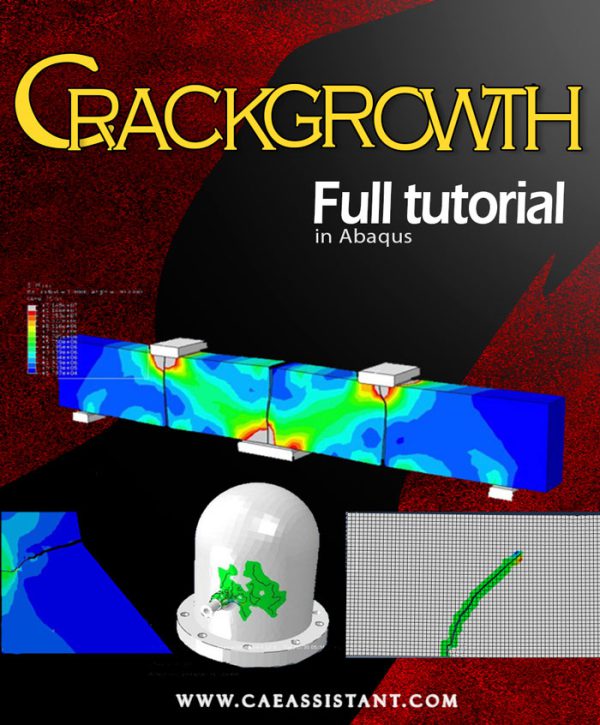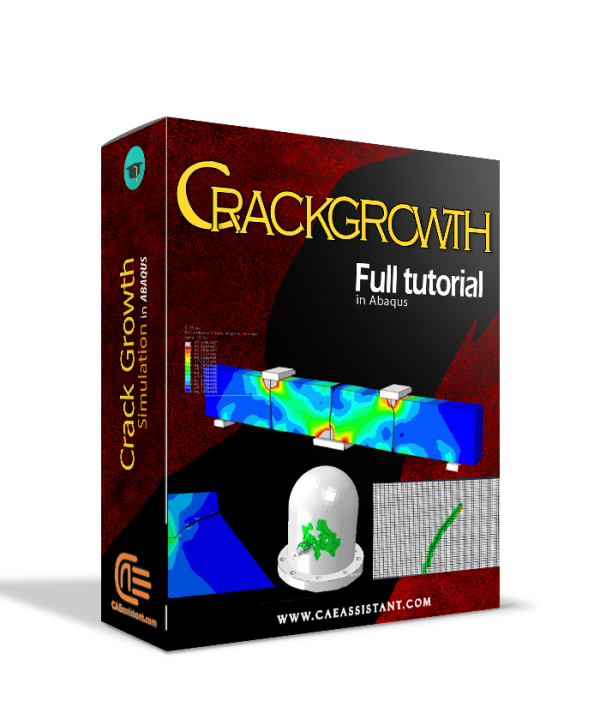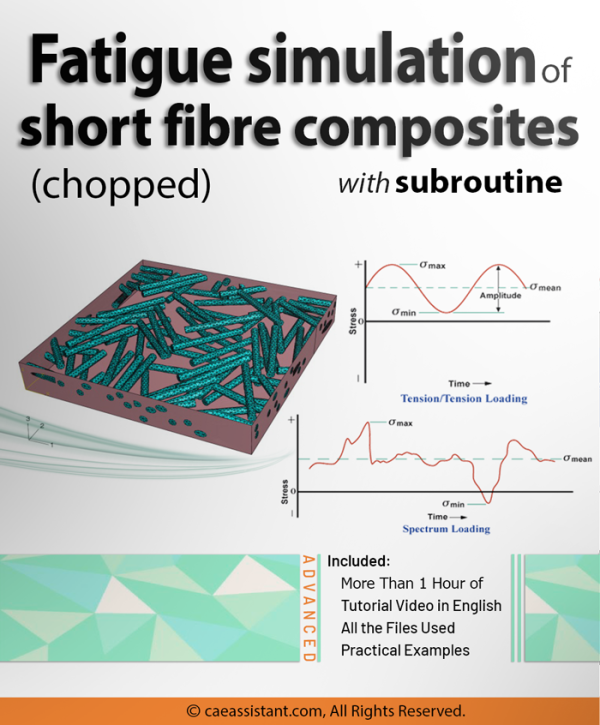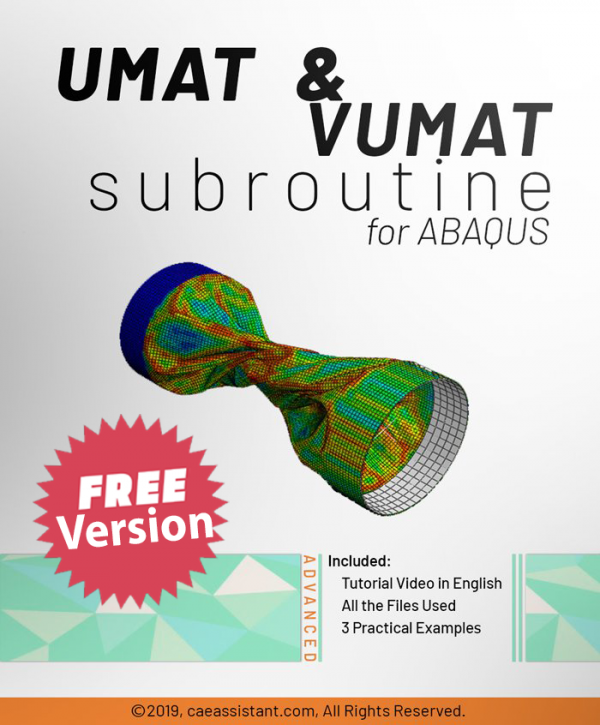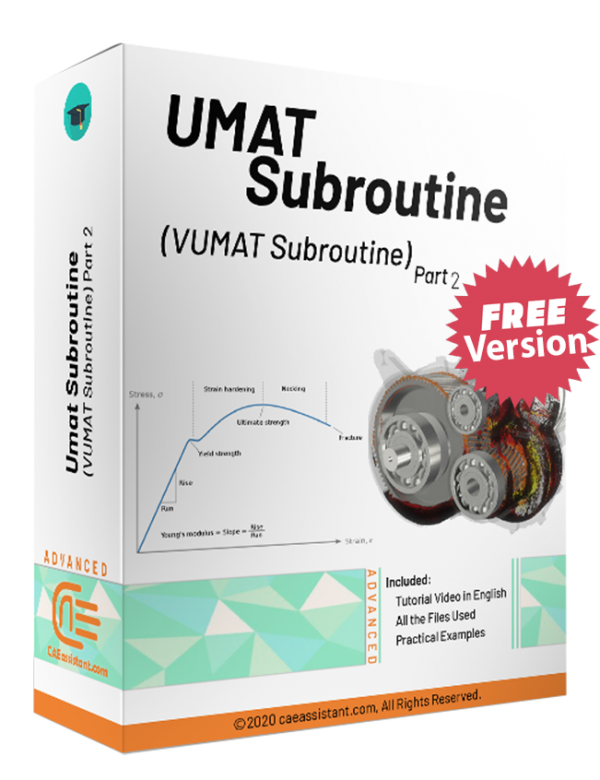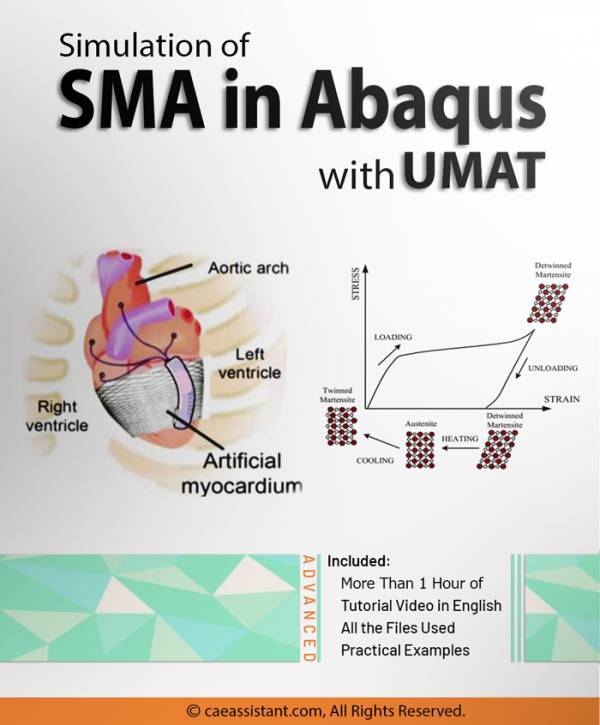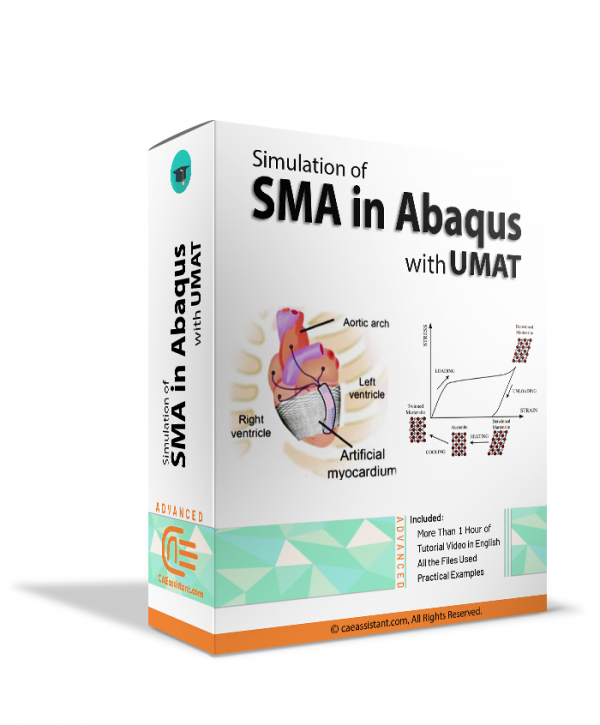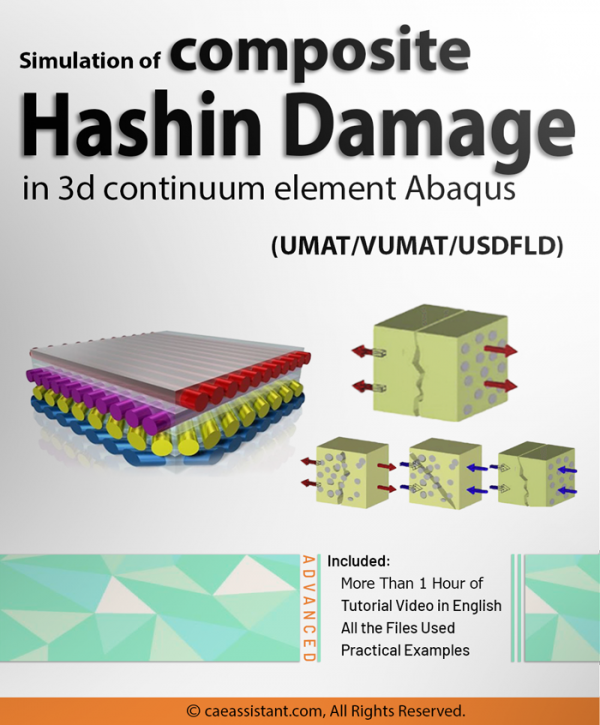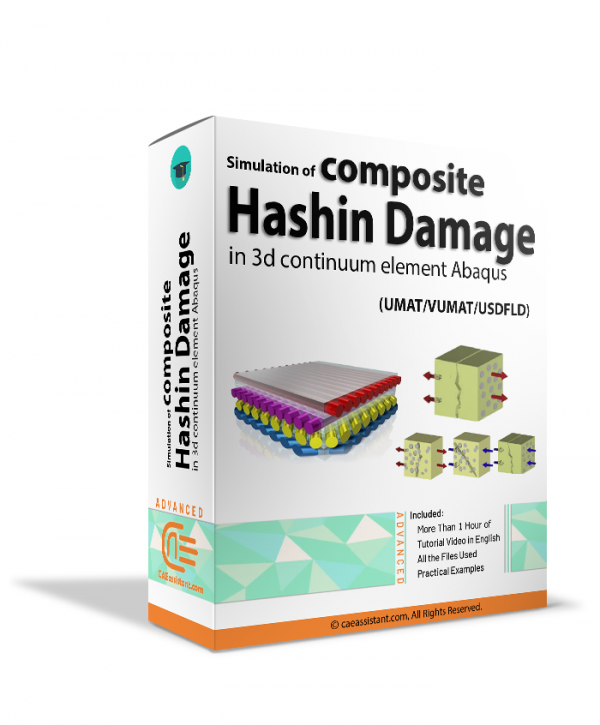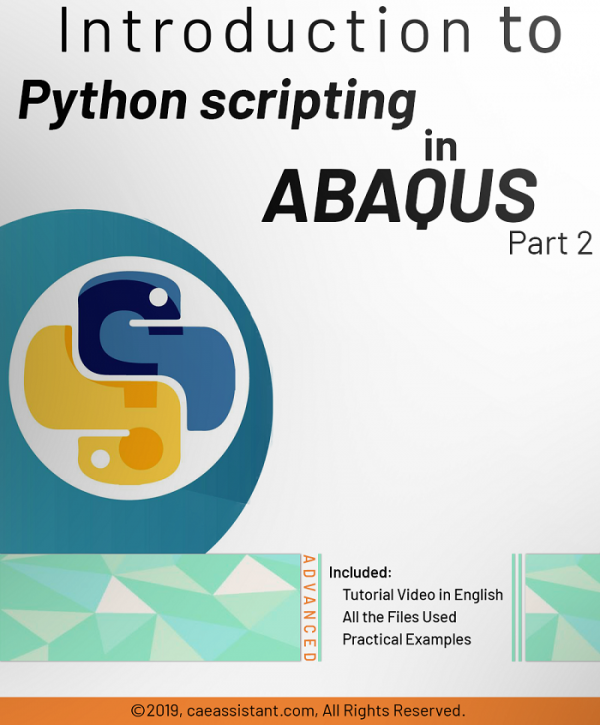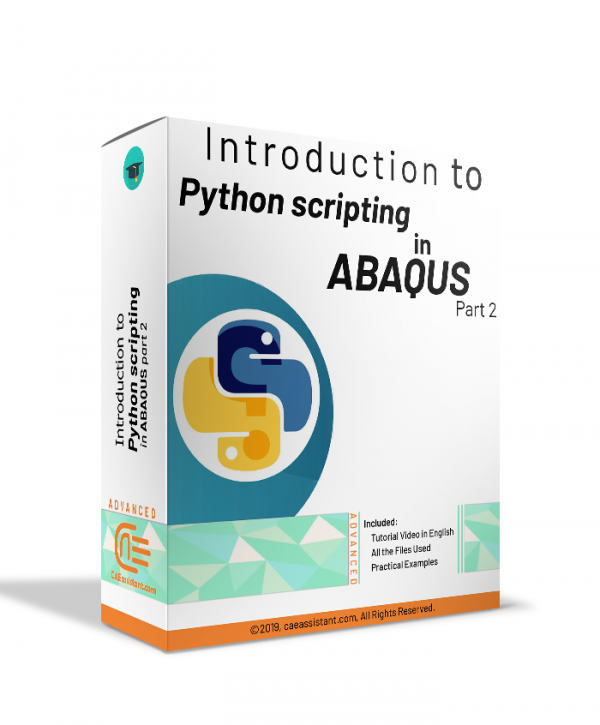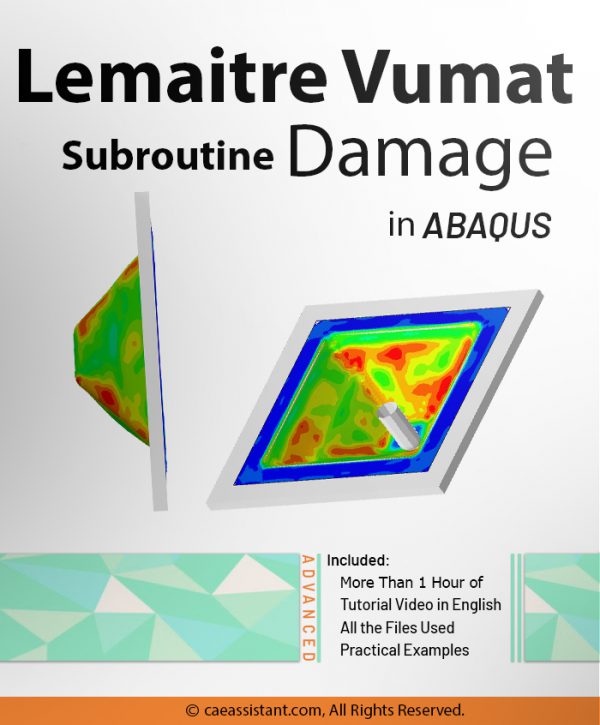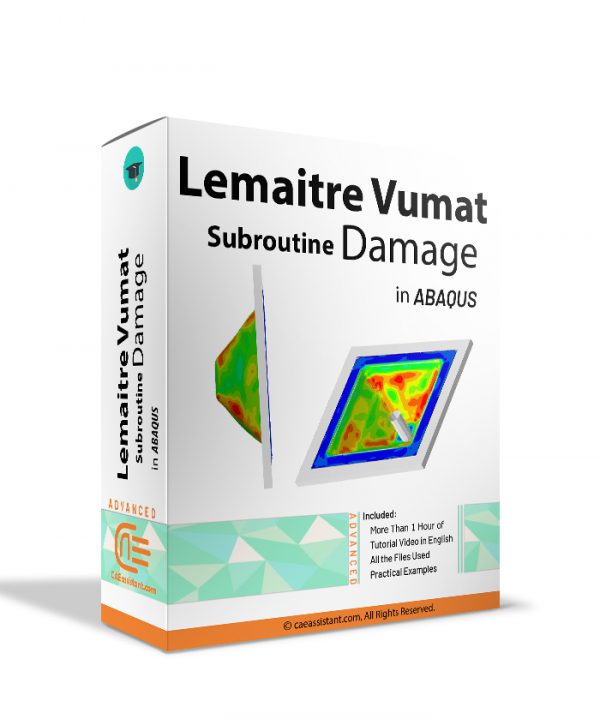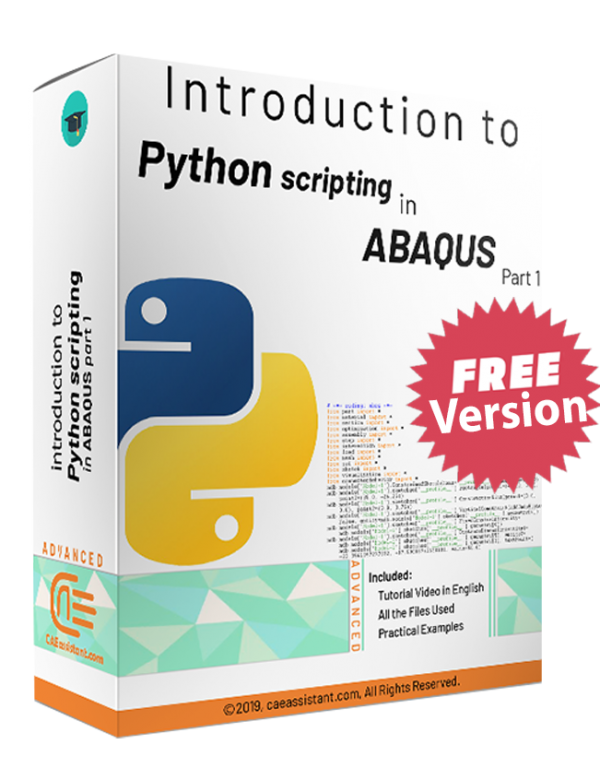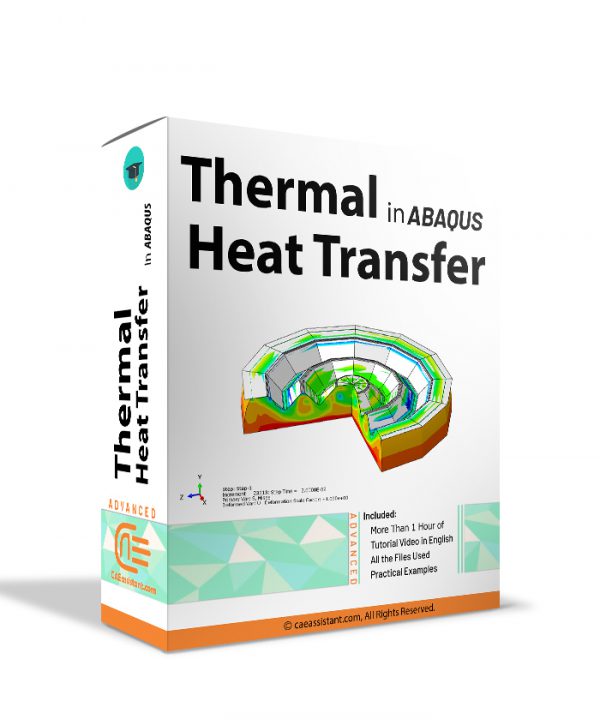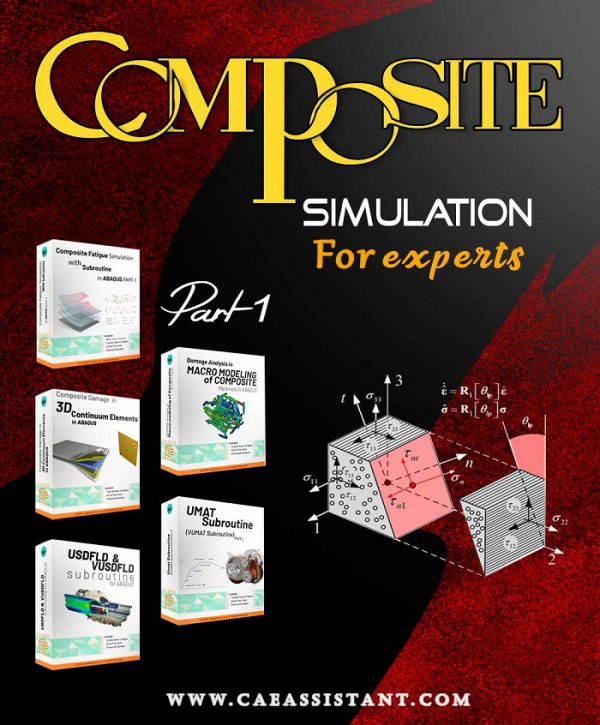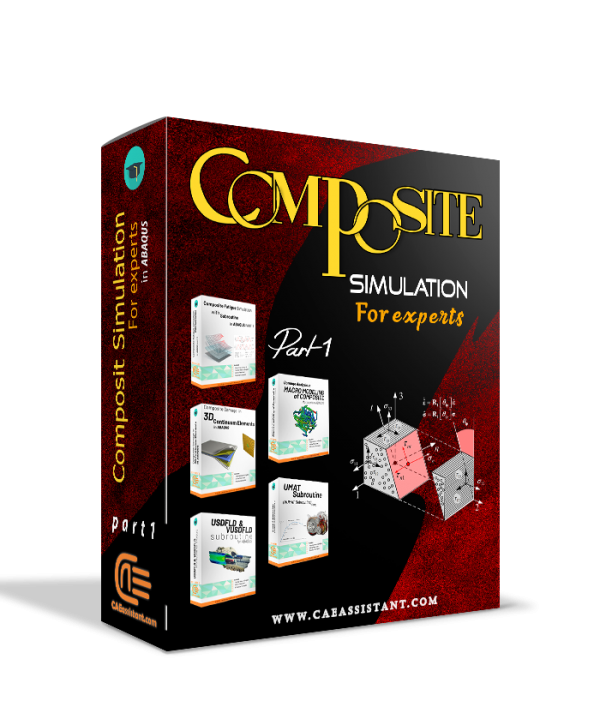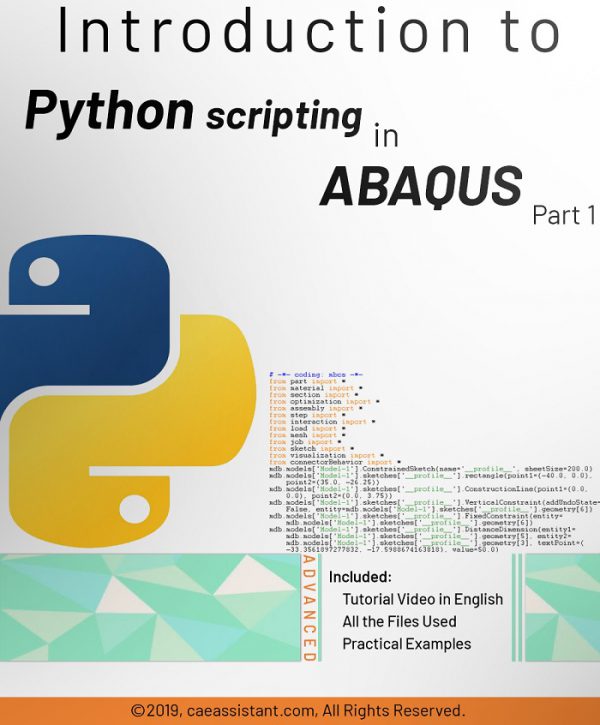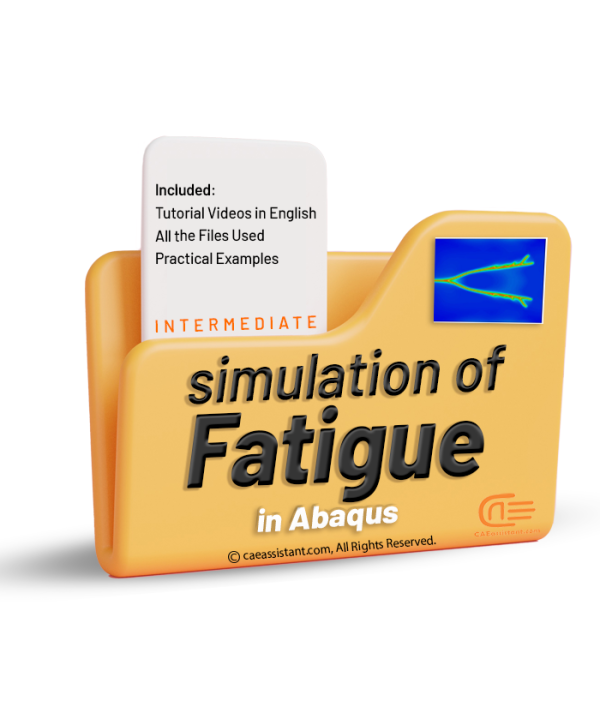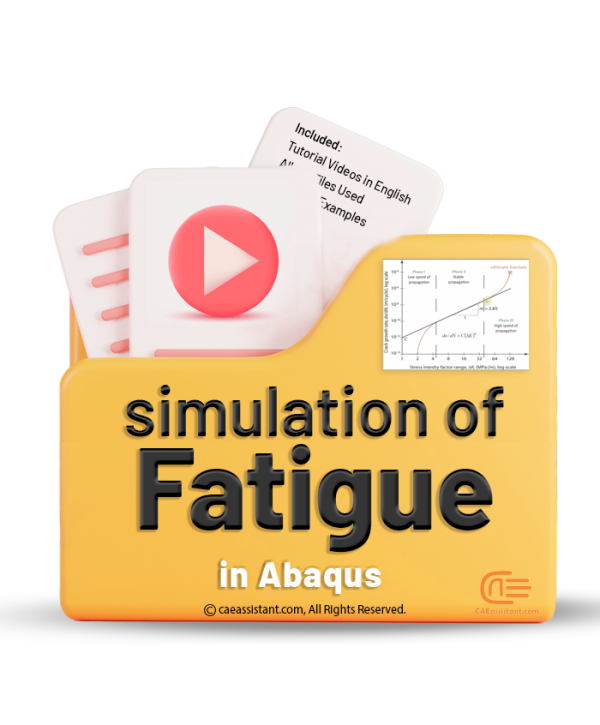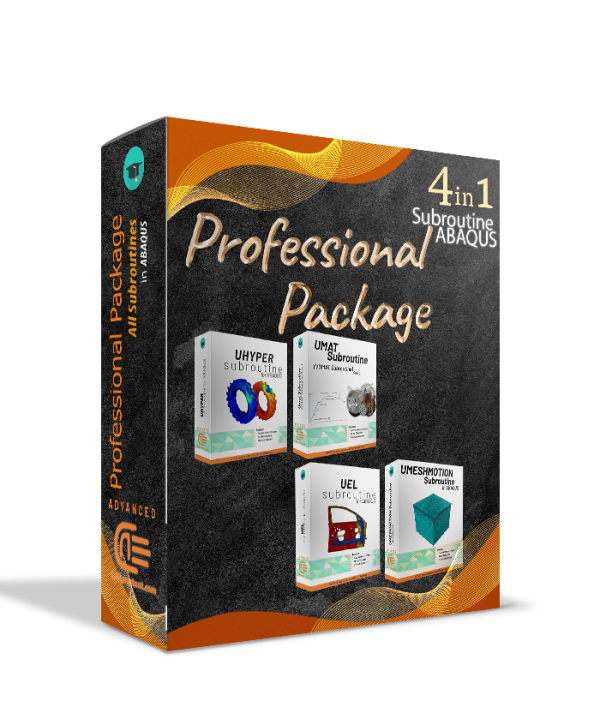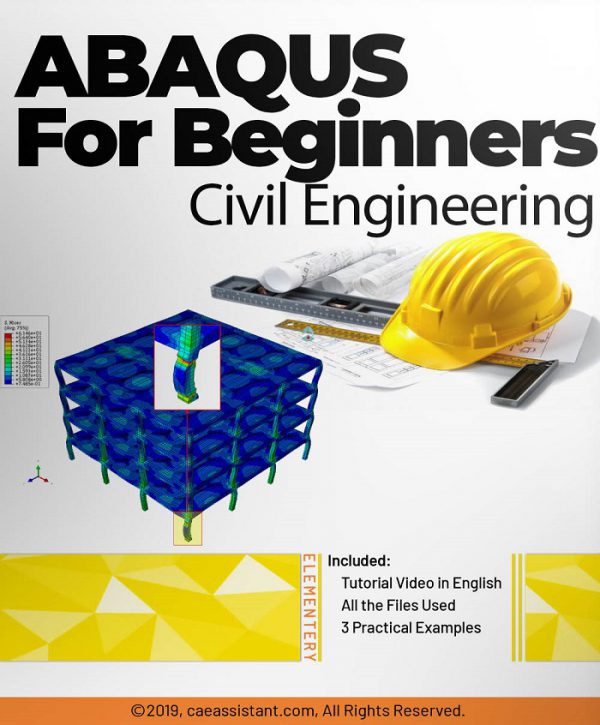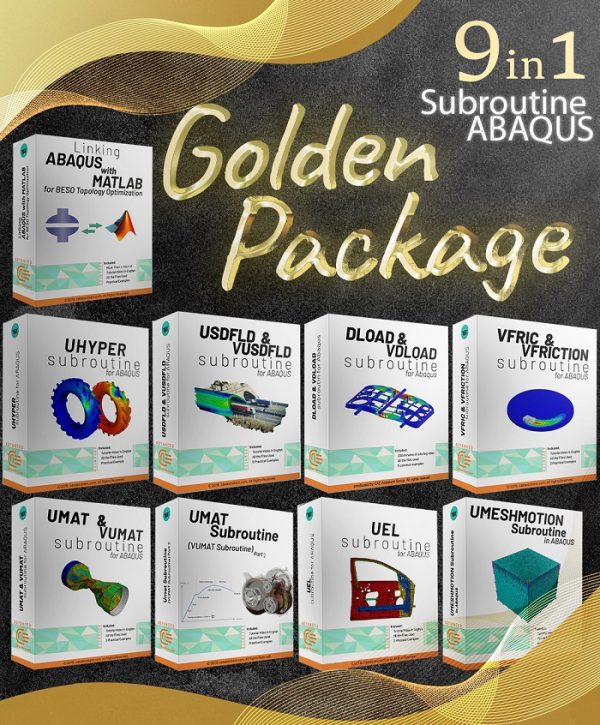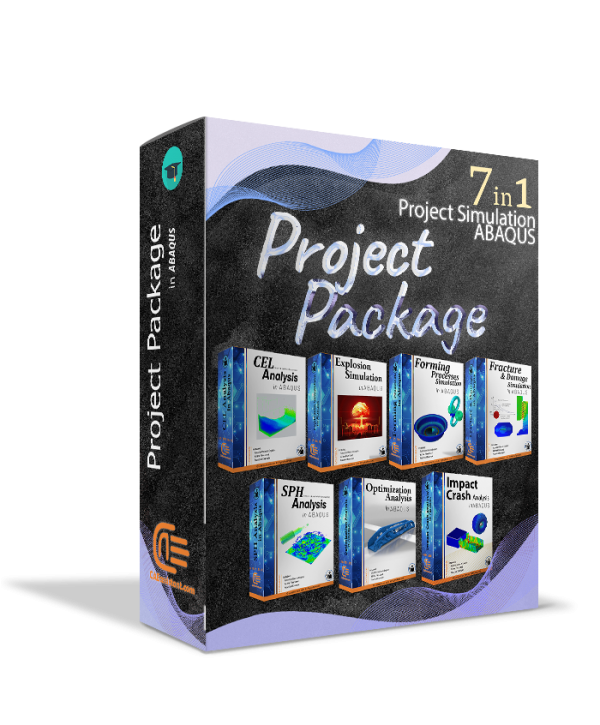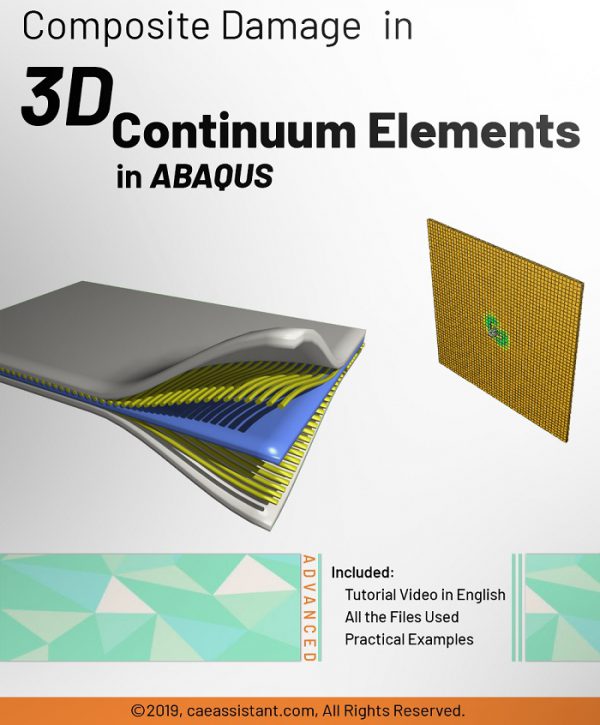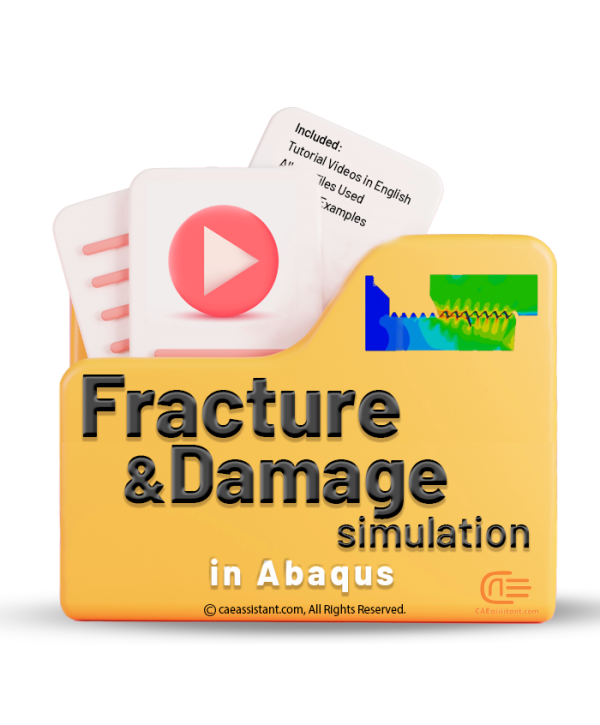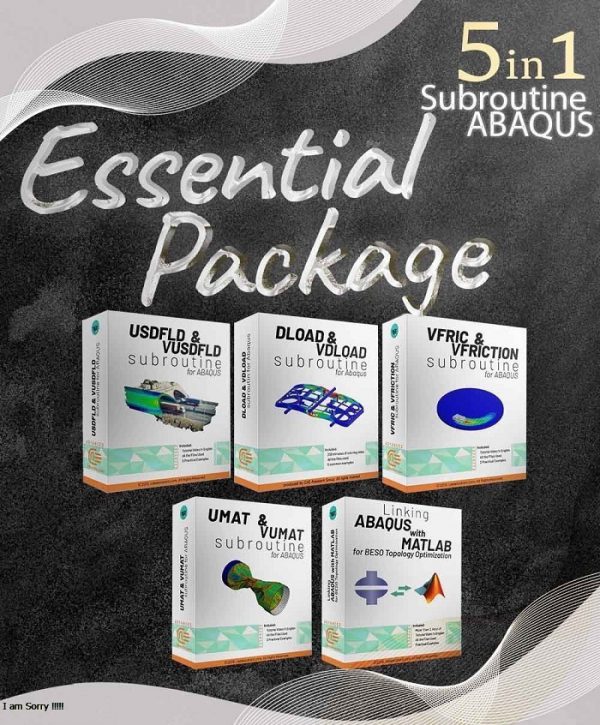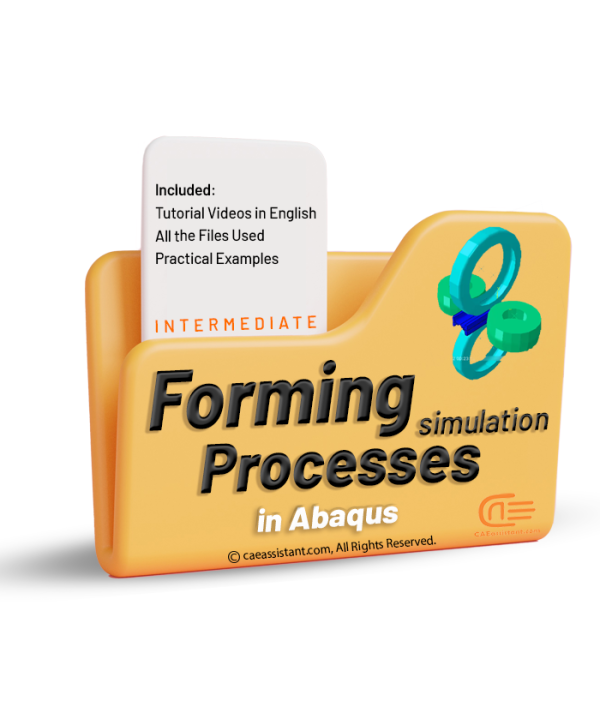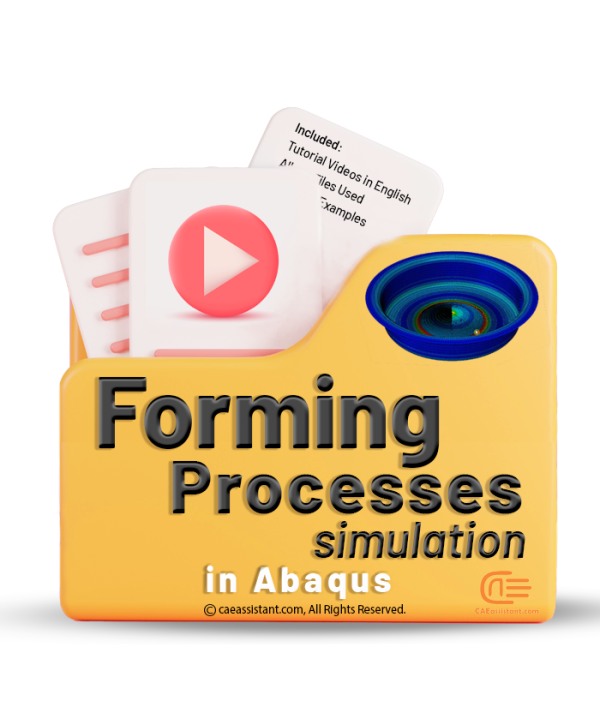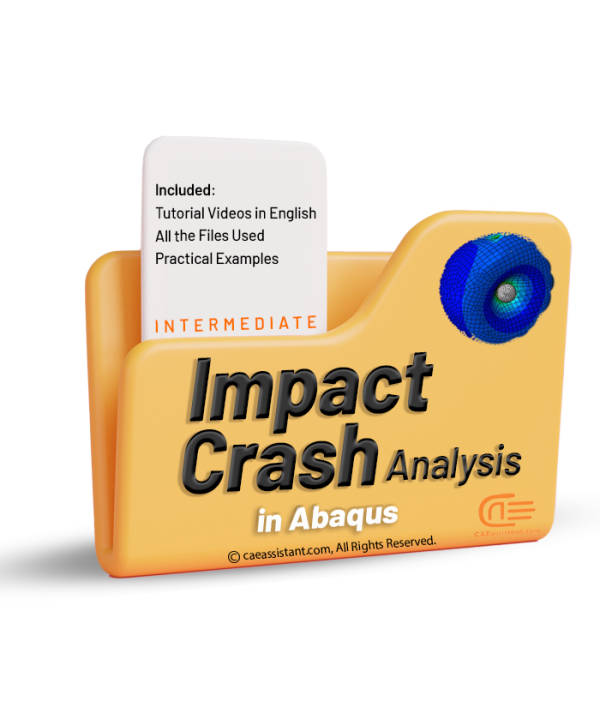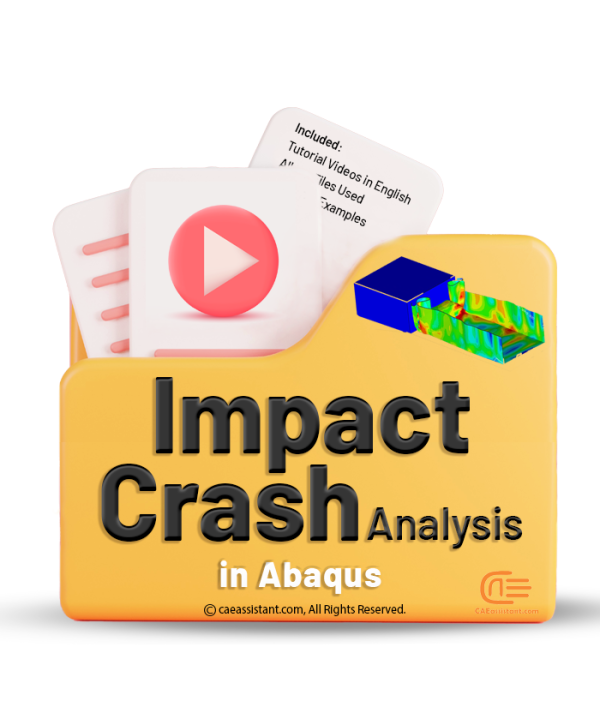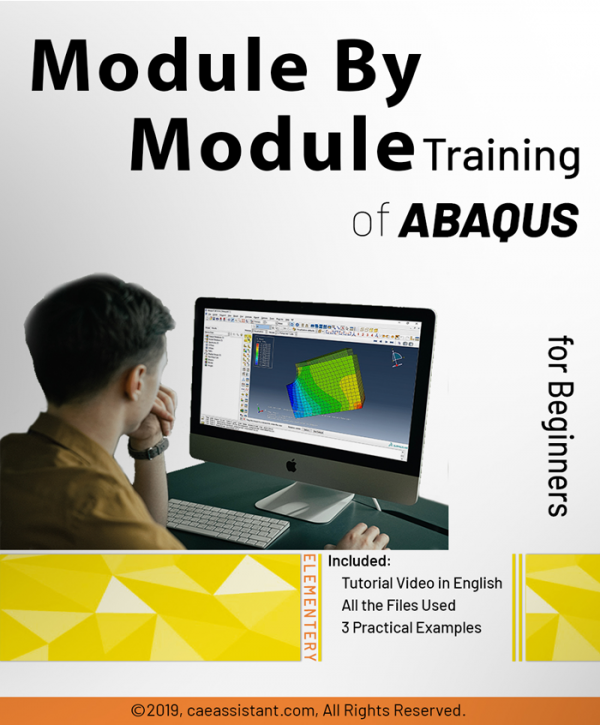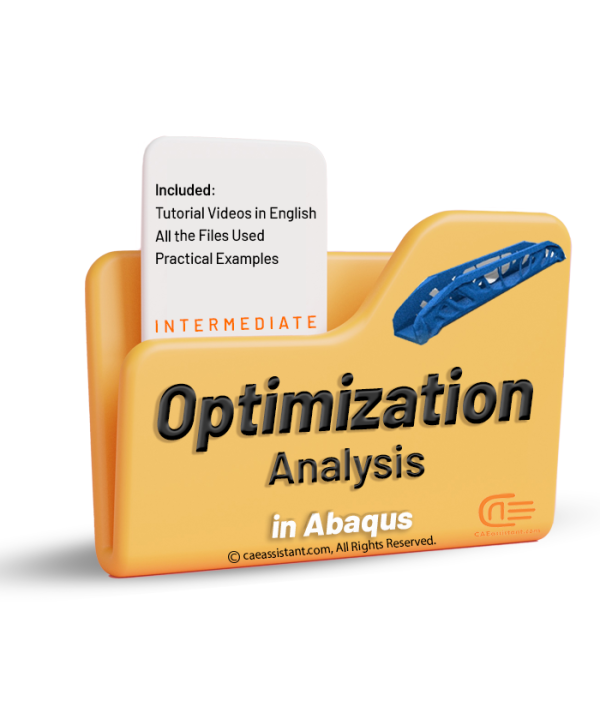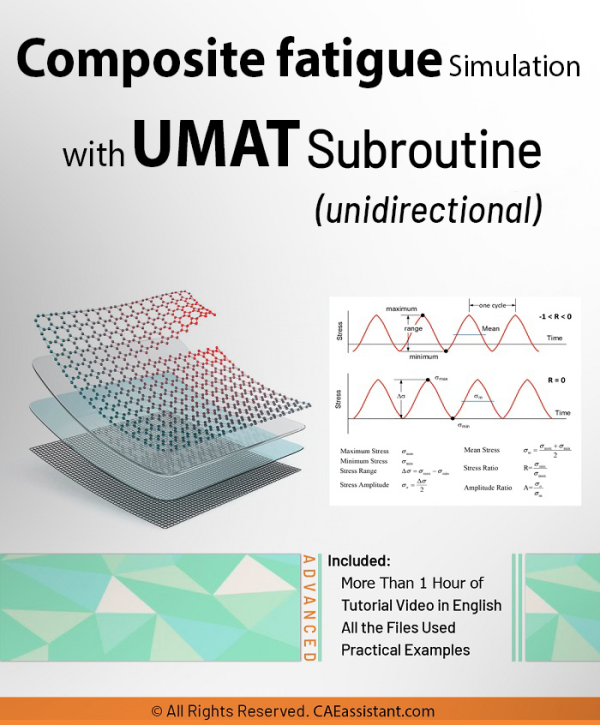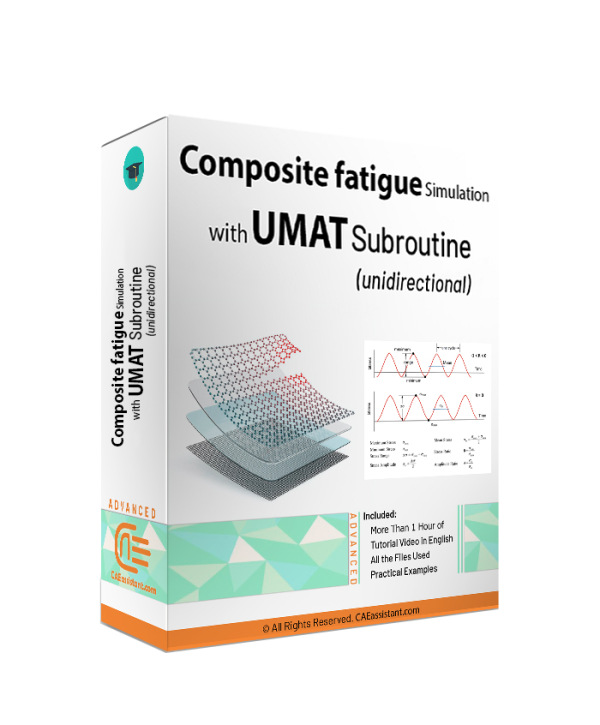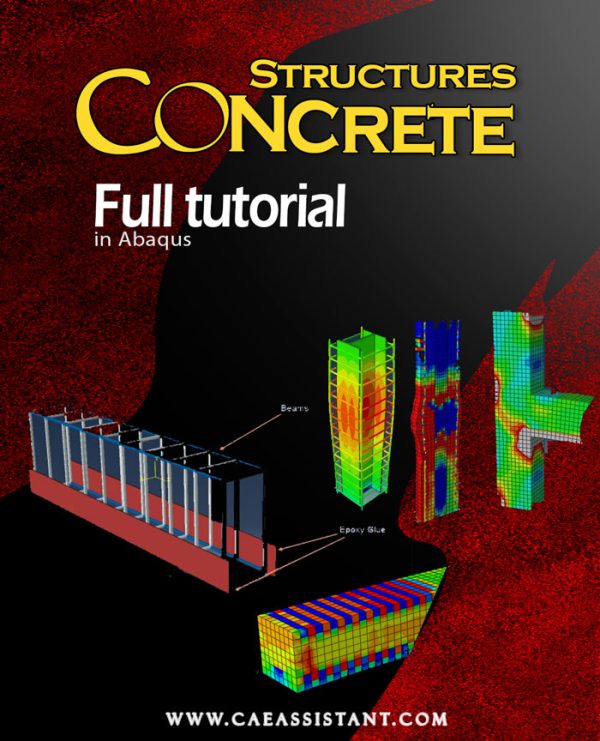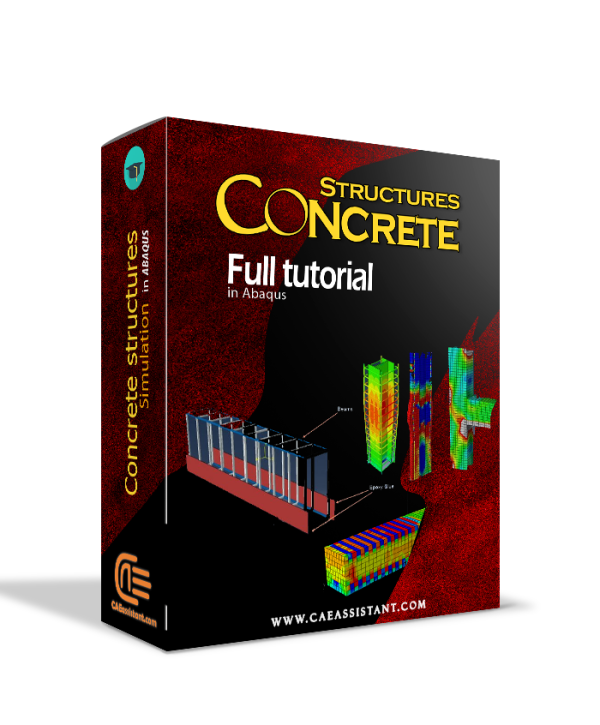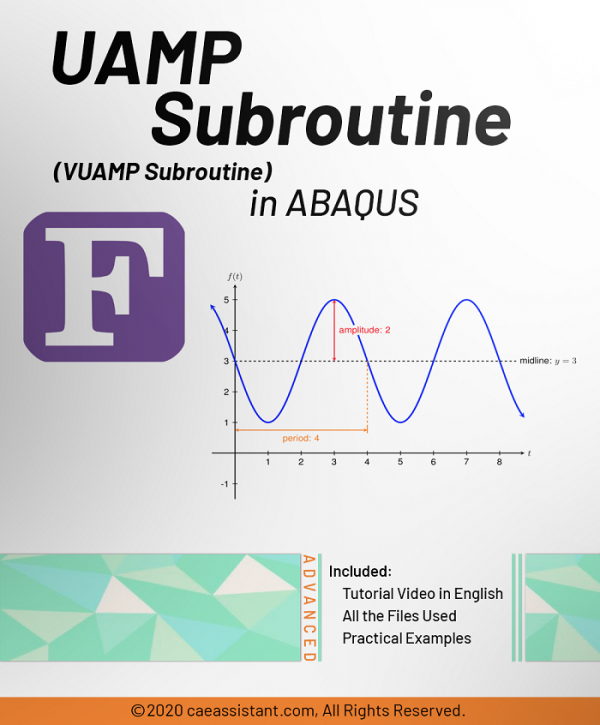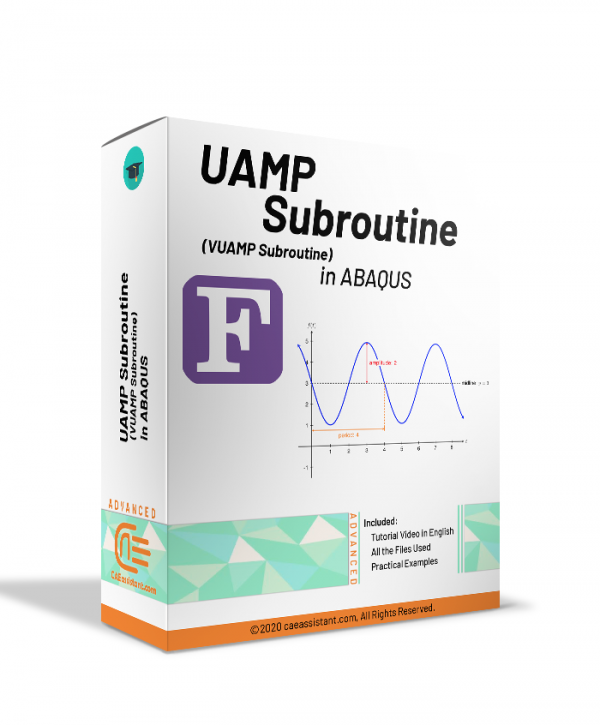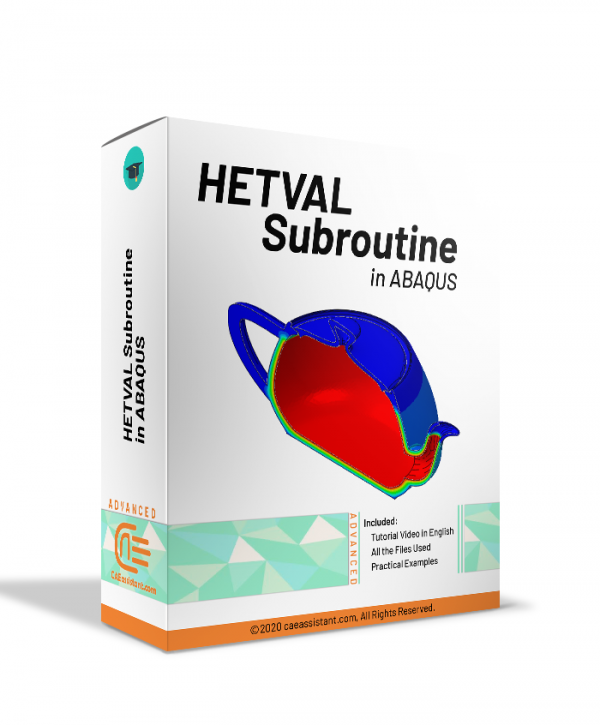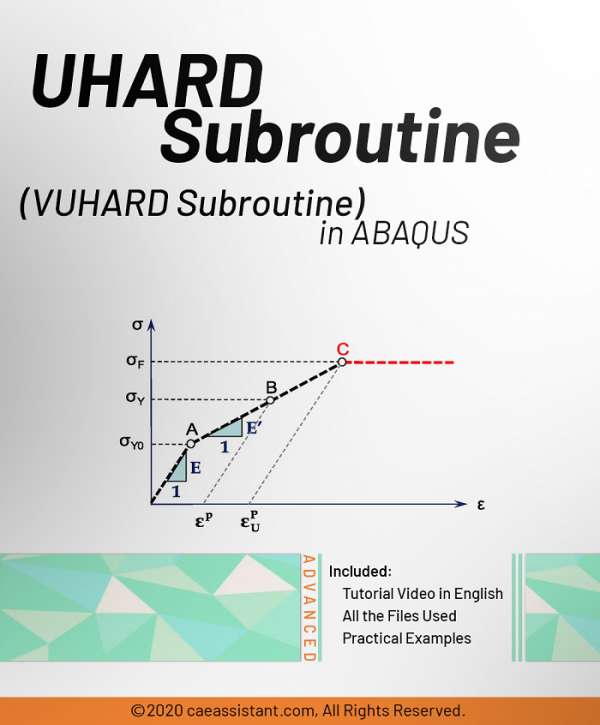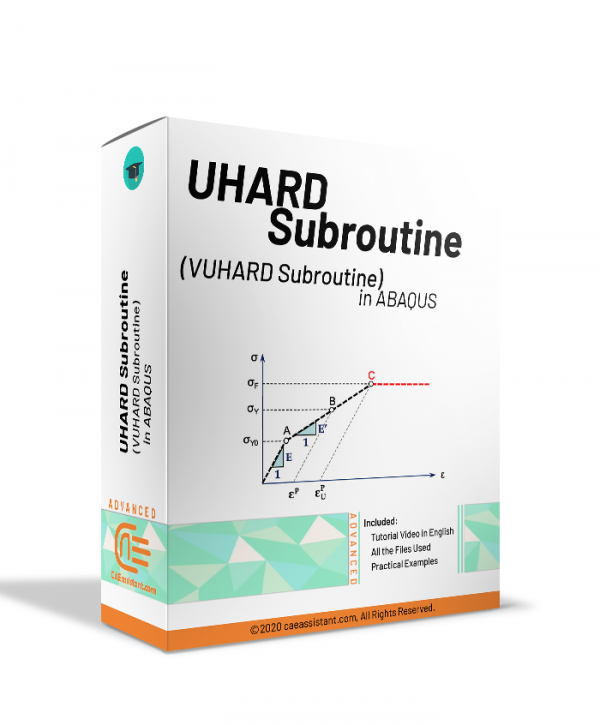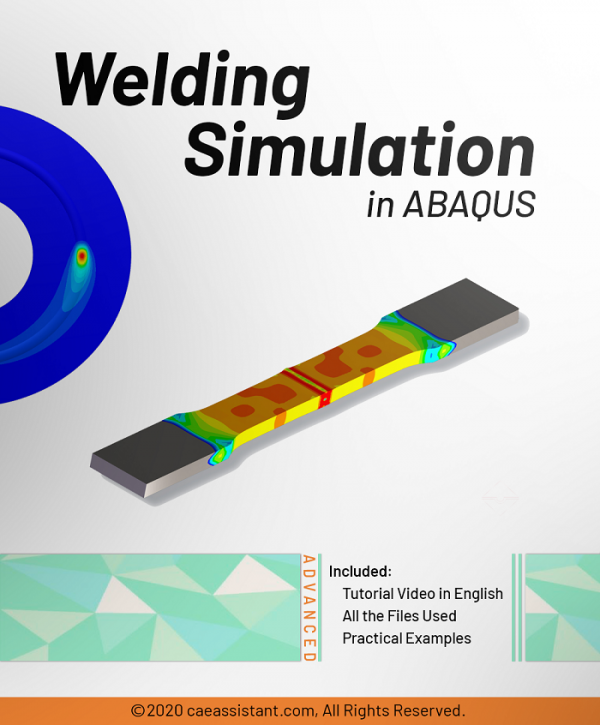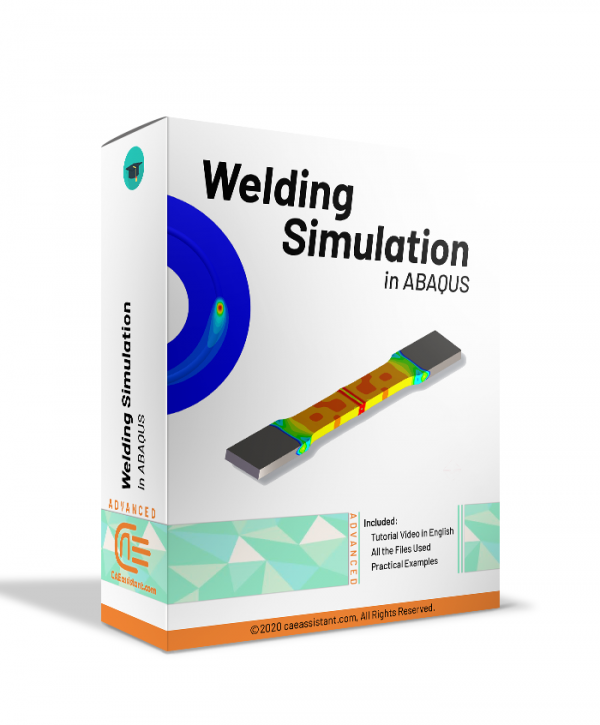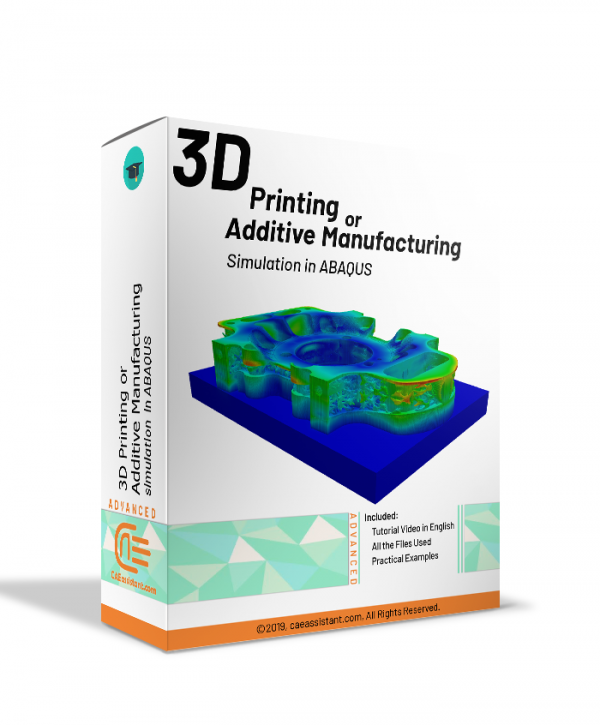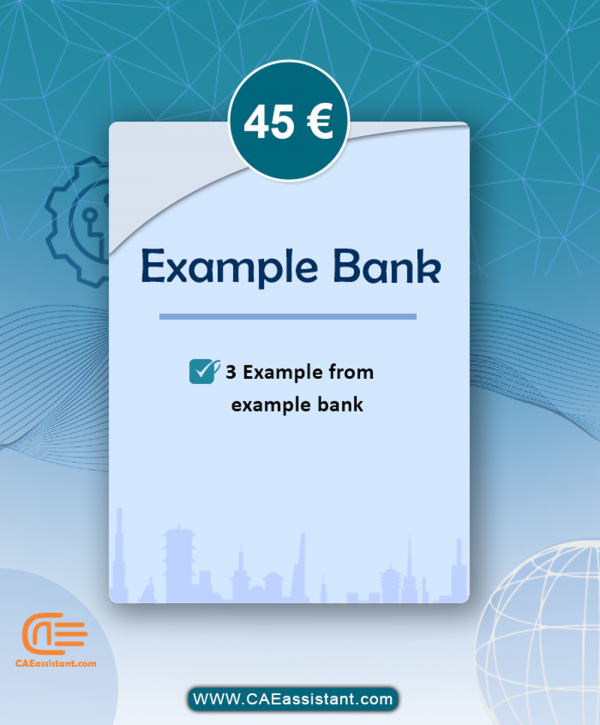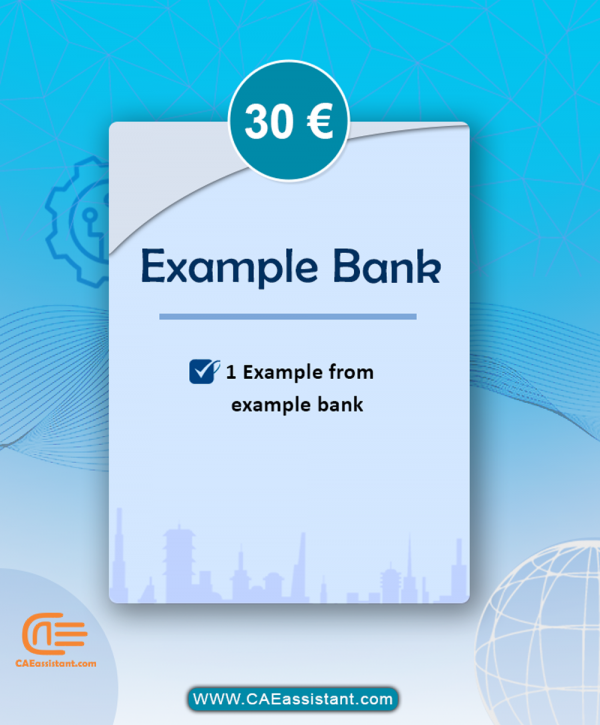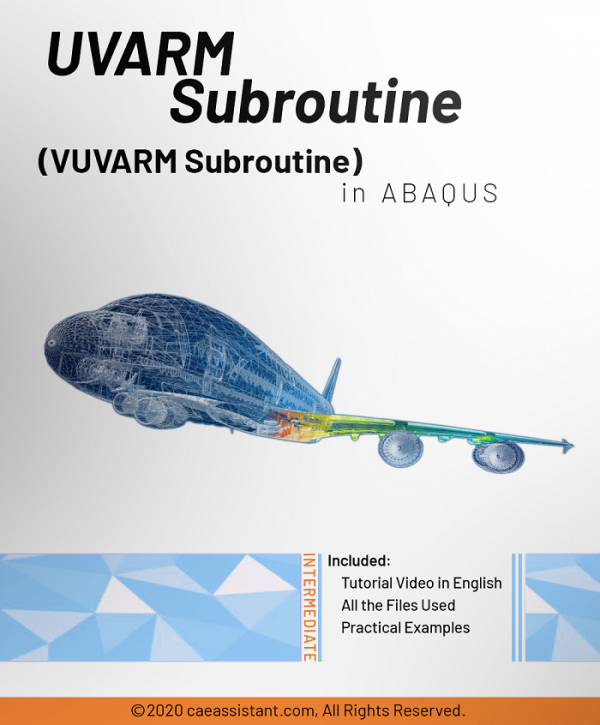abaqus toturial collections
Python Scripting in Abaqus Full Tutorial
€ 635.0If you are a graduate or Ph.D. student, if you are a university professor or an expert engineer in the industry who deals with simulation software, you are definitely familiar with the limitations of this software in defining the material properties, loading or meshing, interaction properties, etc. You have certainly tried to define the properties of materials or geometry based on available features in the software, but sometimes you need to code on your own to define some complex issues.
Now, here is your solution. This full tutorial package includes 3 training packages that help you to learn how to use Python scripting in Abaqus software. This is likewise the most comprehensive tutorial for the script, and it is appropriate for beginners to advanced users.
Additive manufacturing simulation with Abaqus subroutine & python | 3D printing Python
€ 350.03D printing is a technique for creating three-dimensional objects by layering materials such as plastic or metal based on a digital design. 3D printing simulation involves the use of software to predict and enhance the printing process, resulting in more efficient and precise production. This training package is based on the use of subroutines and Python scripting. Following an introduction to the 3D printing process, this method with all its details is explained. Two workshops are then conducted for this method. The first workshop covers 3D printing simulation of a gear with a uniform cross-section, while the second workshop covers a shaft with a non-uniform cross-section.
Johnson Cook Abaqus plasticity and damage simulation
€ 140.0To drive new ideas, we occasionally need to modify the theory of Johnson-equations. Cook’s As a result, we learn how to use the Abaqus model for Johnson Cook theory as well as how to create subroutines for this model in this training package. There are already two written subroutines. You will learn how to apply Johnson-Cook progressive damage in the second one after learning how to apply Johnson-Cook plasticity and damage initiation in the first.
Damage simulation of short fibre composites with subroutine
€ 340.0Short fiber composites consist of chopped fibers and a matrix, forming a discontinuous fiber-reinforced material, with fibers typically positioned either aligned or randomly within the matrix based on the intended application. In this training package, you will learn how to model the short fiber composite (SFC) damage in Abaqus based on this article: “Damage Modeling in Random Short Glass Fiber Reinforced Composites Including Permanent Strain and Unilateral Effect”. In the lesson one, you will learn the fundamentals such as the SFCs advantages, applications, and etc. Moving on to Lesson 2, the focus shifts to modeling Short Fiber Composites in Abaqus. The lesson introduces the critical decision between Macro and Micro modeling, which this package do a macro modeling. Lesson 3 advances the learning journey by exploring damage modeling in Short Fiber Composites, particularly through Dano’s model. This macroscopic approach incorporates irreversible processes and internal variables, addressing anisotropic damage, unilateral effects, and residual effects. Lesson 4 bridges theory to practical application, guiding users on how to implement Dano’s model in Abaqus through the VUSDFLD subroutine. The tutorial navigates through the subroutine’s flowchart, explaining each line sequentially. Complementing the lessons are two workshops. Workshop 1 features a 2D composite plate with a hole using plane stress elements, offering a detailed breakdown of material properties, boundary conditions, and simulation procedures. Workshop 2, mirroring the first, employs shell elements, showcasing variations in element types while maintaining consistency with the utilization of the VUSDFLD subroutine.
Bio-Mechanical Abaqus simulation Full package
€ 370.0In this project package, numerous methods of bio-mechanical simulation are examined through ten step-by-step tutorials. Every tutorial includes all needed files and step-by-step English videos and is explained from A to Z.
Abaqus Soil Modeling Full Tutorial
€ 280.0All facets of soil modelling and simulation are covered in this full tutorial. The package includes twenty titles on topics such as soil, saturated soil, TBM, earthquake, tunnel, excavation, embankment construction, geocell reinforced soil, geosynthetic-reinforced soil retaining wall, soil consolidation in interaction with the concrete pile, earthquake over gravity dam, infinite element method, sequential construction, calculation of the total load capacity of the pile group, bearing capacity of the foundation. Package duration: +600 minutes
Abaqus steel material and structures Full Tutorial
€ 490.0Here in this training package, numerous models of crack steel material structures modeling, such as the shear failure, FLD criterion and different metal damage theories in concrete, steel, dams, and bones are examined through ten step-by-step tutorials. Every tutorial includes all needed files and step-by-step English videos and is explained from A to Z.
Abaqus Crack Growth Full Tutorial
€ 410.0Here in this training package, numerous methods of crack propagation modeling, such as the XFEM and H integral and so on, in concrete, steel, dams, bones, and other materials are examined through ten step-by-step tutorials. Every tutorial includes all needed files and a step-by-step English videos and is explained from A to Z. Package duration: +300 minutes
Fatigue damage simulation of short fibre composites with subroutine
€ 340.0Fatigue failure in materials occurs when repetitive or fluctuating stresses, below the ultimate strength and often below the yield limit, lead to sudden and unpredictable failure, making it a significant concern in engineering due to its potential for catastrophic consequences. The reinforced part of the fiber-reinforced composites can be categorized as continuous or discontinuous, with the latter referred to as short fiber-reinforced composites. In this training package, the fatigue of short (chopped) fiber composites is explained. Two fatigue damage models are presented for short fiber composites: Nouri fatigue damage model and Avanzini fatigue damage model. The Nouri’s model is applicable for composites with orthotropic behavior. But the Avanzini’s model has considered the fiber distribution in the matrix to be homogeneous and random. It has assumed the material behavior to be isotropic. Also, Nouri’s model was developed for strain-controlled test, but Avanzini’s model was developed for stress-controlled test. In this tutorial, we use the Avanzini’s model, which is base on this article: “Fatigue behavior and cyclic damage of peek short fiber reinforced composites”. This article has implemented the USDFLD subroutine, but we use the UMAT subroutine, which is more accurate than USDFLD since the material strength and properties reduction is smooth. A standard test specimen is used in this simulation to model such behavior. You will learn the details in the package.
UMAT Subroutine (VUMAT Subroutine) in ABAQUS-Free Version- UMAT Abaqus example
€ 0.0This package includes the free version of the two following packages. The following packages include 11 workshops for writing different types of subroutines and give you instructions and points to write your own UMAT/VUMAT subroutine. Here, a UMAT Abaqus example is free to download.
“UMAT Subroutine (VUMAT Subroutine) introduction” is used when the material model is not available in ABAQUS software. If you follow this tutorial package, including standard and explicit solver, you will have the ability to write, debug and verify your subroutine based on customized material to use this in complex structures. These lectures are the introduction to writing advanced UMAT and VUMAT subroutines in hyperelastic Martials, Composites, and Metal, and so on. Watch Demo
“Advanced UMAT Subroutine (VUMAT Subroutine)” training package helps Abaqus users to prepare complex UMAT and VUMAT subroutines. This training package is suitable for those who are familiar with subroutine or want to learn UMAT/VUMAT subroutine Professionally. Equations for computational plasticity based on kinematic stiffness are also discussed. In addition, metal damage has been implemented based on Johnson Cook’s model. Watch Demo
Simulation of SMA in Abaqus with UMAT
€ 320.0Shape-memory alloys (SMAs) have the ability to recover their original shape, thanks to the shape-memory effect and superelasticity. These unique characteristics have led to the broad usage of SMAs in engineering and medical applications. Simulations offer cost-effective methods for analyzing SMAs’ behavior, ultimately enhancing their reliability and performance. Consequently, researchers frequently employ simulations to investigate SMA-based systems. This educational package begins by exploring the fundamentals of SMA wires, presenting their various types and specific capabilities. It then provides the necessary constitutive equations to describe the behavior of SMAs in simulation. The package includes a flowchart and a step-by-step guide for writing a subroutine to model SMAs in Abaqus. Users will also discover a workshop that uses Abaqus to simulate the superelasticity effect in SMA wires. This workshop not only offers guidance on the simulation and the implementation of the subroutine, but also compares the result with an analytical solution for verification.
Simulation of composite Hashin damage in 3d continuum element in Abaqus (UMAT-VUMAT-USDFLD)
€ 250.0In this training package, the 3D continuum HASHIN damage initiation model is prepared via three subroutines (USDFLD, UMAT and VUMAT).This training package teach you subroutines line-by-line. It should be noted that after damage initiation, failure occurs suddenly and in the form of a reduction in properties in the model. The HASHIN theory for this package is based on Kermanidis article titled” FINITE ELEMENT MODELING OF DAMAGE ACCUMULATION IN BOLTED COMPOSITE JOINTS UNDER INCREMENTAL TENSILE LOADING “.
Python scripting in ABAQUS Part 2
€ 240.0This training package includes workshops that help you to learn about advanced Python scripting in Abaqus software. This is the most comprehensive tutorial containing advanced ways to write the Abaqus script. The subjects such as interrogation in output databases, Kernel plug-ins, RSG plug-ins, etc., are covered in this tutorial.
Lemaitre Damage model implementation with VUMAT Abaqus
€ 250.0The Lemaitre damage model is now widely used to deal with coupled damage analyses for
various mechanical applications.
In this package, Firstly, we try to introduce the Lemaitre damage model, including damage mechanics and formulation of the Lemaitre damage model. Then, writing the Lemaitre subroutine is reached step by step. To do this job, the flowchart of the subroutine, Writing the subroutine line by line, implementation of the subroutine in one element and verification is done. In the last chapter, we implement this subroutine in a complex problem, the upsetting process.
Python scripting in ABAQUS-(FREE Version)
€ 0.0This training package(free version) includes one of three and two of five workshops that help you to partially learn how to use Python scripting in Abaqus software. This is likewise the most comprehensive tutorial for the script, and it is appropriate for beginners to advanced users. The subjects such as parameterization, optimization, sequential running and etc. are covered in this tutorial.
To access the full version of this package, click here. It should be mentioned, that the free version of this package, it is not included software files and scripts.
Thermal Heat Transfer in Abaqus
€ 120.0This package is related to Thermal Analysis in Abaqus. This package helps Abaqus users to simulate professionally.
In general, Abaqus can solve the following types of heat transfer problems (For thermal and thermo-mechanical problems):
- Uncoupled heat transfer analysis
- Sequentially coupled thermal-stress analysis
- Fully coupled thermal-stress analysis
- Adiabatic analysis
Composite simulation for experts-Part-1
€ 930.0If you are a graduate or Ph.D. student, if you are a university professor or an expert engineer in the industry who deals with simulation software, you are definitely familiar with the limitations of this software in defining the material properties, loading or meshing, interaction properties, and etc. You have certainly tried to define the properties of materials based on advanced fracture theories in finite element software and are familiar with their limitations and problems.
Now, here is your solution. Start writing subroutines in finite element software and overcome the limitations. With the tutorials in the Golden Package, you will learn how to write 8 subroutines in Abaqus software professionally.
Python scripting in ABAQUS Part1
€ 195.0This training package includes workshops that help you to learn how to use Python scripting in Abaqus software. This is likewise the most comprehensive tutorial for the script, and it is appropriate for beginners to advanced users. The subjects such as parameterization, optimization, sequential running and etc., are covered in this tutorial.
Simulation of Fatigue in Abaqus
€ 45.0This training package includes workshops that teach you the XFEM method to simulate crack growth. This tutorial package enables you to model crack propagation in any 2D and 3D dimensional model. In addition, you will learn about the Paris law, direct cyclic approach, traction-separation law, and other theories that help you to simulate a crack growth problem in this package
Analysis of Heat Transfer in Abaqus
€ 75.0This Analysis of Heat Transfer in Abaqus package includes workshops that help you to fully learn how to simulate the temperature distribution and heat flux in solids under thermal loads. This tutorial package enables you to model thermal responses including all the modes of heat transfer, namely conduction, convection and radiation. The subjects such as using film conditions to simulate the convective heat transfer, the dissipation of the frictional heat generated, thermomechanical analysis and etc. are covered in this package
Professional Package
€ 750.0As a professional Abaqus user, you have probably faced cases where you have to move meshes and elements during analysis. For example, there is such a need in the wearing process. In addition, to define the properties of materials based on advanced theories of elasticity or plasticity, you need programming within the software. Sometimes you may need to model different types of cohesive or many types of composite materials based on various methods of composite damage. In all these cases, be sure that the professional package will answer you. This package is designed and prepared for you who are professionals and work on the edge of knowledge topics in the field of mechanical engineering and damage mechanics.
Sometimes you may need to use user-defined elements and change element configuration based on theories that you are using; for instance, it is needed to add more integration points in elements. In this case, you can use the UEL package in the “Professional Package”.
💿Abaqus Tutorial for Beginners (Abaqus Tutorial for Civil Engineering)
€ 270.0In the present Abaqus tutorial for civil engineering package, we, “The CAE Assistant”, have presented all the Abaqus basic skills that a civil engineer needs when he/she wants to use his/her engineering knowledge in computer-aided designing. Abaqus tutorial for civil engineering covers all your need to simulate concrete, reinforcements, buckling, frequency, damage, composite, cohesive and more topics related to Abaqus structural analysis tutorial. You can watch the demo video for more information.
Golden Package
€ 1510.0If you are a graduate or Ph.D. student, if you are a university professor or an expert engineer in the industry who deals with simulation software, you are definitely familiar with the limitations of this software in defining the material properties, loading or meshing, interaction properties, and etc. You have certainly tried to define the properties of materials based on advanced fracture theories in finite element software and are familiar with their limitations and problems.
Now, here is your solution. Start writing subroutines in finite element software and overcome the limitations. With the tutorials in the Golden Package, you will learn how to write 8 subroutines in Abaqus software professionally.
ABAQUS Projects Package
€ 373.0If you need common industrial simulations in the fields of forming, fracture, explosion, impact, etc., this package can provide you with comprehensive training along with an instructional video file and software file. You can quickly meet your educational needs in learning the elementary and intermediate level of Abaqus software using this package.
3D continuum Abaqus HASHIN progressive Damage for composite materials (VUMAT Subroutine)
€ 320.0This tutorial teaches how to simulate damage in 3d continuum composite materials in ABAQUS. As you know, Abaqus does not have any material model for 3d composite materials. So, the user needs to write a customized subroutine to simulate damage initiation and progressive damage for composite materials in ABAQUS. In this package, one of the most practical damage initiation criteria (Hashin) is used to detect failure. It should be mentioned that this subroutine includes gradual progressive damage based on the energy method. This complex subroutine could be used for static and dynamic problems.
Simulation of Fracture in Abaqus
€ 75.0This package is usable because crack growth and beyond it Fracture phenomenon is one of the most important problems in engineering and getting information about this topic, lets you reduce unpredictable failures in components.
Essential Package
€ 710.0In this package, you can get comprehensive training of the following very useful four subroutines at a lower cost. In this package, more than 9 hours of practical training in the form of videos, PowerPoint, and workshops are provided.
During the years of our activities, many students and professors have received these 5 practical packages from us, and we decided to offer this popular package in the form of the “Essential Package” at a reasonable price.
We assure you that by providing this package, you will be answered to how to define the properties of complex materials or complex loads and contacts very quickly and will save you a lot of time. Because in the training workshops of these packages, there are several practical examples for using these subroutines that can make you a professional in writing them quickly.
Simulation of forming in ABAQUS
€ 70.0The forming in Abaqus is one of the most important manufacturing processes that can be used for producing different components. In this package, you will learn how to simulate the forming process in Abaqus and you can see the behavior of the material along this process. This package contains some examples that cover rolling, hydroforming, extrusion, ECAP, Cold forging, and drilling processes.
Notice: You can access this package 3 days after purchase.
Simulation of impact in ABAQUS
€ 60.0Impact in Abaqus is one of the most important mechanical tests used to check safety before construction. Due to the expansion of the use of this test in the industry, including the automotive industry, the importance of the issue has increased. In this package, by presenting 7 workshops, we try to teach you most of the capabilities of Abaqus software for this widely used topic.
Module by module Abaqus Training
€ 60.0If you are new to Abaqus software and the topic of finite element analysis, you definitely need to get acquainted with the user interface of this software and the general features of each module.
In this software, we perform different simulation steps in the following different modules and at the end, we receive the analysis results from the software solver.
In this package, you will learn how to work with the software in each module and perform your simulation in each module properly.
Optimization in ABAQUS Analysis
€ 51.0This tutorial teaches how optimize topology of a model in ABAQUS. Structural optimization is an iterative process that helps to improve designs and produce parts and components that are lightweight, strong and long-lasting.
Topology optimization begins with an initial design, which is assumed to be the maximum physical extent of the component, and determines a new material distribution by changing the density and the stiffness of the elements in the initial design while continuing to satisfy the optimization constraints. In this package different workshops to implement topology optimization are used.
Composite Fatigue Simulation with UMAT Subroutine in ABAQUS (unidirectional)
€ 420.0The composite fatigue training package completely teaches how to simulate and analyze a fatigue composite model with the help of UMAT Subroutine in Abaqus software. In this training package, we have provided all the files needed for your training, including articles, theories, how to write subroutines, and software settings.
Advanced UMAT Subroutine (VUMAT Subroutine) – Abaqus UMAT tutorial
€ 240.0This training package helps Abaqus users to prepare complex UMAT and VUMAT subroutines. This Abaqus UMAT tutorial package is suitable for those who are familiar with subroutine or want to learn UMAT/VUMAT subroutine Professionally. Equations for computational plasticity based on kinematic stiffness are also discussed. In addition, metal damage has been implemented based on Johnson Cook’s model.
Abaqus Concrete structure Modeling Full Tutorial
€ 600.0The package includes 19 workshops on topics such as concrete, beam-column structures, composites, steel rebars, Ultra-High-Performance-Fiber-Reinforcement Concrete columns, CFRP bars, hollow-core square reinforced concrete columns wrapped, damaged concrete beams, High Strength Concrete(HSC),ECC/Concrete Composite Beam-Column Joints, circular concrete-encased concrete-filled steel tube (CFST) stub columns, and etc. Every tutorial includes all needed files and step-by-step English videos and is explained from A to Z. Package duration: +600 minutes
UMESHMOTION subroutine in ABAQUS
€ 240.0If you want to define motion for mesh nodes, you must use the UMESHMOTION subroutine. This subroutine helps you to specify Mesh Motion constraints during adaptive meshing. In this tutorial package, you will learn when you need to use the UMESHMOTION subroutine and how to use it. This package contains three workshops: “writing UMESHMOTION subroutine in forming process”, “writing UMESHMOTION subroutine in rolling process”, and “Tread wear simulation via UMESHMOTION”. The Archard model is used in the wear process, which is very popular in academic and industrial projects.
UAMP subroutine (VUAMP subroutine) in ABAQUS
€ 250.0This package introduces UAMP and VUAMP subroutines in Abaqus. The UAMP and VUAMP refer to User-Defined amplitude. In Abaqus, load amplitude refers to the time-varying function that defines the magnitude and pattern of a load applied to a model during analysis. This amplitude can be defined using predefined amplitude functions or by creating a user-defined amplitude using the UAMP or VUAMP subroutines. The load amplitude can be applied to various types of loads including force, pressure, displacement, and temperature, allowing for a wide range of loading scenarios to be simulated in the analysis. The load amplitude plays a critical role in determining the response of the model over time. The UAMP and VUAMP subroutines can be determined by a mathematical time-dependent function or using sensor values that are defined by the user in analysis. In Abaqus, sensors are used to monitor and extract data from a simulation during its execution. In this package, you will learn all about the UAMP and VUAMP subroutines, all of their variables, how to work with them, their differences, and other things along with educational workshops to help you understand working with these subroutines.
HETVAL subroutine in ABAQUS
€ 210.0HETVAL is a user subroutine specifically developed to address the limitations of Abaqus in accurately handling volumetric heat flux resulting from internal heat generation within materials. The subroutine’s functionality depends on factors such as time, temperature, or evolving state variables, stored as solution-dependent variables. Accordingly, it can tackle scenarios involving phase changes during simulations. Moreover, the subroutine allows the integration of kinetic theory to account for phase changes associated with internal heat release, such as predicting crystallization in polymer casting processes. Such a multi-functional subroutine finds applications in heat transfer analyses, coupled thermal-electric studies, or temperature-displacement analyses. In this package, our primary goal is to provide valuable insights into the HETVAL subroutine and its diverse applications. Afterward, through a series of comprehensive workshops, we will guide participants in utilizing HETVAL under various conditions. In the final workshop, a problem will be presented, allowing you to explore a realistic example and gain hands-on experience in simulating the curing process within fiber-reinforced composites using HETVAL. Furthermore, to assist those unfamiliar with fiber-reinforced composites, we have included an introductory lesson covering their applications, significance, and an explanation of the importance of accurately simulating the curing process. By completing this package, you will have gained a comprehensive understanding of utilizing HETVAL across various conditions and scenarios. Moreover, you will have acquired the ability to simulate the heat generated during the curing process of fiber-reinforced composites, demonstrating a real-world application of HETVAL.
UHARD Subroutine (VUHARD Subroutine) in ABAQUS
€ 140.0UHARD stands for user-defined hardening models. For isotropic plasticity or combined hardening models, UHARD is a user subroutine to define the yield surface size and hardening parameters. In this tutorial package, you will learn when you need to use this subroutine first; Next, how to use the UHARD & VUHARD subroutine; After that, the difference between the UHARD & VUHARD subroutines and last, there will be four workshops to teach how to use them in action. The workshops are: Implementation of UHARD Subroutine for isotropic hardening (formulation based) in a simple model, Deep Drawing simulation with VUHARD Subroutine or isotropic hardening Data-based with element removal, Simulation of material under pressure with UHARD Subroutine as internal subroutine combined with UMAT, and Simulation of incremental forming with VUHARD Subroutine Dharmasena modified Based.
DFLUX Subroutine (VDFLUX Subroutine) in ABAQUS
€ 180.0DFLUX subroutine (VDFLUX Subroutine) is used for thermal loading in various body flux and surface flux states in heat transfer and temperature displacement solvers when flux load is a function of time, place, or other parameters. In this package, you will learn “when do you need to use this subroutine?”, “how to use the DFLUX subroutine”, “what is the difference between DFLUX & VDFLUX?”, “how to convert DFLUX to VDFLUX and vice versa?”, and “How to use it in an example?”. Three workshops are presented so you can learn all these stuff in action: Simulation of welding between two plate with DFLUX subroutine, Simulation of Arc welding between two tube with DFLUX, and Simulation of different types of functional heat flux(Body-surface-Element) in plate with Johnson-cook plasticity with VDFLUX subroutine(Thermomechanical Analysis).
Forming simulations in ABAQUS
€ 170.0
In this training package, different types of forming simulations are presented along with different tips. These points include increasing the solution speed, different types of plasticity and damage models, different solvers, Lagrangian, CEL, and SPH methods and etc.
Welding Simulation in ABAQUS
€ 230.0This training package fully covers the various possible methods for welding simulation. First, an introduction to welding and two basic categories of welding, fusion and non-fusion welding. Next, the theories and the elements used to simulate the welding will be explained. These theories are Lagrangian, Eulerian, ALE, and SPH. After that, you will learn how to apply these theories with different methods, such as the death and birth of an element, DFLUX subroutine, etc. Finally, you will learn how to simulate welding with the help of five workshops: Friction Stir Welding (FSW) simulation with the Eulerian element, Explosive welding simulation, simulation of FSW with the SPH method, Butt welding with death and birth of an element method, and Simulation of Arc welding between two tubes with DFLUX subroutine (Thermomechanical Analysis).
Additive Manufacturing or 3D Printing Abaqus simulation
€ 440.03D printing is a process of creating three-dimensional objects by layering materials, such as plastic or metal, based on a digital design. 3D printing simulation involves using software to predict and optimize the printing process, allowing for more efficient and accurate production. This educational package includes two 3D printing modeling methods. The first method is based on the use of subroutines and Python scripting. After an introduction to the 3D printing process, the first method with all of its detail is explained; then, there would be two workshops for this method; the first workshop is for the 3D printing simulation of a gear with uniform cross-section and the second one is for a shaft with non-uniform cross-section. The second method uses a plug-in called AM Modeler. With this plug-in, the type of 3D printing can be selected, and after inserting the required inputs and applying some settings, the 3D printing simulation is done without any need for coding. Two main workshops will be taught to learn how to use this plug-in: “Sequential thermomechanical analysis of simple cube one-direction with LPBF 3D printing method using the trajectory-based method with AM plug-in” and “3D printing simulation with Fusion deposition modeling and Laser direct energy deposition method with AM plug-in”.
Explosion simulation in ABAQUS
€ 140.0This training package teaches simulation of the explosion in ABAQUS with a variety of examples. In this training package, different methods for implementation are discussed.
ABAQUS course for beginners | FEM simulation tutorial
€ 256.0In this Abaqus course for beginners, which is designed for FEM Simulation students in mechanical engineering, various examples in the most widely used fields are presented. These examples are provided with the necessary points and theories for simulation. With this training package, you will be able to get acquainted with different ABAQUS modules in the form of various examples in modeling, how to get the output and the necessary results for reporting. You can download the syllabus of this package here.
Three Examples from Example Bank
€ 45.0In the Example Bank, there are hundreds of ready-made modeling examples that can help you in the simulations related to your project. By seeing similar examples, you can get an idea of how to prepare your model in Abaqus.
You can order three examples for 45 Euros and start modeling your project and if you had more questions and ambiguities order training packages and other products.
One Example from Example Bank
€ 30.0In the Example Bank, there are hundreds of ready-made modeling examples that can help you in the simulations related to your project. By seeing similar examples, you can get an idea of how to prepare your model in Abaqus.
You can order one example for 25Euros and start modeling your project and if you had more questions and ambiguities order training packages and other products.
UVARM subroutine in ABAQUS
€ 75.0“UVARM subroutine in ABAQUS” package teaches how to specify user-defined output variables at all material calculation points of elements for academic and industrial projects.
UMAT Subroutine (VUMAT Subroutine) introduction
€ 150.0This package is usable when the material model is not available in ABAQUS software. If you follow this tutorial package, including standard and explicit solver, you will have the ability to write, debug and verify your subroutine based on customized material to use this in complex structures. These lectures are an introduction to write advanced UMAT and VUMAT subroutines in hyperelastic Martials, Composites and Metal and so on.
